Cookbook #249: Grilling and Barbecue, Cook’s Illustrated Guide, a Best Recipe Classic, by the editors of Cook’s Illustrated, Brookline, MA, 2005.
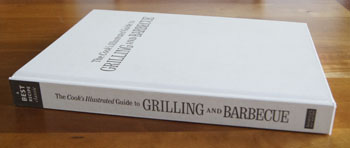 My second-to-last cookbook in this 250 Cookbooks blog! Hard to believe this 5-year project is coming to an end.
My second-to-last cookbook in this 250 Cookbooks blog! Hard to believe this 5-year project is coming to an end.
Cook’s Illustrated guide cookbooks are always among my favorites. Besides Grilling and Barbecue, I also have Cover and Bake and Best International Recipe. I’ve discussed the style of Cook’s Illustrated recipes in my previous posts on those two books. Briefly, you don’t just get a recipe, you get pages of discussion about how that recipe was developed – what they tried that did and did not work. Further information about ingredients and techniques is presented in boxes or side notes. I find that a Cook’s Illustrated recipe might take a bit more concentration to follow than common recipes, but the recipes always work for me. These guide books are all big, heavy, hardback, white-covered tomes.
I have eight “grilling” cookbooks, but this is one of my two “go-to” books for barbecue – the other is Weber’s Real Grilling. Weber’s Real Grilling is specific to gas grills, while Cook’s Illustrated Grilling and Barbecue gives for each recipe methods for both charcoal grilling and gas grilling. We have a gas grill, and I have no desire to cook with charcoal. The gas grill is just too easy! I’ll just say “I’m sorry” to those purists who think charcoal is the only way to grill!
Grilling and Barbecue begins with introductory sections on “Outdoor Cooking 101″ and Equipment and Tools for Outdoor Cooking”. They are quite useful and complete.
The first chapter is “Beef”. Strip and rib steaks, porterhouse and T-bone steaks, filets mignons, steak tips, flank steaks, London broil, hamburgers, prime rib, beef tenderloin, veal chops, beef ribs, and beef brisket are each discussed in detail, describing how to get the most out of each cut of beef. Specific recipes, sauces, salsas, marinades, and rubs are suggested, some of which appear in later chapters in the book.
The section on in the Beef chapter on “Does Branding Matter?” catches my eye. It begins: “To guarantee quality, more and more people are looking beyond the confines of their local supermarket butcher case and buying their steaks through mail order sources. These outlets promise all-star beef with a price tag to match”. I read on with interest, since I have tried mail order steaks in the past. The folks at Cook’s Illustrated did a thorough study of both local supermarket and mail order steaks. The steak that won first place in their taste tests is a mail order brand that cost $68/pound (Lobel’s Wagyu, or Kobe-style steak from Oakleigh Ranch in Australia). “We found that money can buy you happiness, if happiness for you is the best steak you ever ate”. But the “good news” is that you don’t have to spend a small fortune “or pay for shipping” to get a great steak. Coleman Natural steak, available at some supermarkets, is only $14 a pound and came in second in their taste tests. (Note the publication date of this book: 2005. We know prices have changed since then.)
Pork, lamb, chicken, turkey and other birds, fish, shellfish, vegetables, and pizza and bruschetta chapters follow in the same detail and style as the beef chapter. Sides and salads, rubs and sauces round out the book.
I think a study “kebabs” would be a good illustration of “Grilling and Barbecue, Cook’s Illustrated Guide“. Sure, I’ve made pork, beef, and chicken kebabs so often I rarely use a recipe, but the meat often comes out dry and chewy, or under-cooked, or unflavorful, and the onions and peppers and other vegetables burned or falling apart. I usually make kebabs the same way, no matter what type of meat I use. Just load up the skewers, brush with a sauce, and put them on the grill – that’s my method. But I decide to use this blog as an opportunity to study how to make really good kebabs. So I turn to the pages and lengthy kebab discussions in this tome – about 4 big pages on average for each type of kebab. Below is what I learn.
First, pork. The problem with pork kebabs is that the pork tastes bland and often dries out on the grill. Cook’s Illustrated tried different cuts of pork, and chose pork loin because it has a full flavor, is tender, and an “appealing resistance when you bite into it”. On their early tries, the pork loin dried out on the grill. To overcome this, they tried both brining and marinating, and chose the marinade method because it not only kept the meat “moist and juicy”, but it added “richness of flavor that was lacking in the lean pork loin”. Also, the oil in the marinade improved the pork’s texture and added other flavors to the meat. Not only that, but cutting the pork loin into 1 1/4 inch cubes and “butterflying” them improved the flavor of this rather neutral meat. To butterfly, each cube is cut almost through at the center before marinating, and then folded back together to skewer as a whole cube. On the gas grill, these cubes cooked best over a “more moderate level of heat” than beef, the grill is covered, and the kebabs are turned a quarter-turn every 2 1/2 minutes for about 9-10 minutes total. Cooking the pork to 145˚ was found to be ideal. A study of fruits and vegetables to accompany the pork on the skewers led them to recommend fresh pineapple in 1-inch chunks, bell peppers in 1-inch pieces, and red onion in 3/4-inch pieces.
Beef kebabs went through a similar study. Results: use top blade (flatiron) steaks or sirloin. Butterfly 1 1/4-inch beef cubes and marinate in a non-acidic olive oil based herb mixture, use the same vegetable and fruits as in pork cubes, grill over direct high heat, cover down, turning one-quarter turn every 1 3/4 minutes, until meat is browned, about 7-8 minutes total.
Finally, chicken kebabs. Use chicken thighs cut into 1 1/2-inch chunks and marinate in a olive oil and salt, non-acidic marinade. Cook’s Illustrated found “early on” that it was clear that cooking chicken and vegetables together on kebabs “enhances the flavor of both”. After a lengthy study, they chose zucchini, eggplant, mushrooms, bell peppers, onions, bell peppers, small shallots, apples, peaches, pears, and fresh pineapple as appropriate for chicken kebabs. (Cook’s Illustrated doesn’t deem potatoes good for kebabs because they require pre-cooking.) They have a handy table that designates the size to cut each recommended fruit and vegetable and whether or not that fruit or vegetable should be marinated. For grilling, they recommend two skewers per kebab, to facilitate turning them without the chicken and vegetables spinning. Grilling should be done on medium high, uncovered, turning one-quarter turn every 2 minutes, until lightly browned, about 9 minutes total.
I am inspired! I’ll carefully follow their instructions and make all these different types of kebabs this summer. Then I can expand to their recipes for fish and shrimp kebabs.
Am I going to make kabobs for this blog? No! Instead, I want to cook a pork tenderloin for the two of us. This is a cut of pork that I use a lot – it’s tender, lean, often on sale, and a perfect portion for two people (with a little left over for the next day’s lunch). I usually simply sprinkle with salt and pepper and cook over direct medium high heat, turning about four times. Grilling and Barbecue says to brine the pork tenderloin, use a wet rub, and cook over high heat 3 minutes per side.
For copyright protection, I am not scanning in this recipe. Below is my adaptation of the original in Grilling and Barbecue, Cook’s Illustrated Guide.
Grilled Pork Tenderloin with Orange, Sage, and Garlic
serves 2
Pork tenderloin and brine
- 1 pork tenderloin, about 1 pound
- 1/3 cup sugar
- 1 1/2 tablespoons salt
- water
Wet spice rub
- 2 cloves garlic, minced fine
- 1 tablespoon grated orange zest
- 1 tablespoon chopped fresh sage leaves
- 1 tablespoon olive oil
- fresh ground pepper to taste
- salt to taste
Remove the “silver skin” from the pork tenderloin: simply slide a sharp knife under this thin piece of tendon on the outside of the tenderloin.
Dissolve the sugar and salt in several cups of water in a shallow bowl. Add the tenderloin and refrigerate about 1 hour. While the pork brines, prepare the wet spice rub – simply mix all the ingredients in a bowl.
Remove the tenderloin from the brining solution, rinse, and dry with paper towels. Rub the wet spice rub into the tenderloin.
Heat a gas grill by turning all the burners to high and with the grill covered. Then, open the gas grill and scrape the cooking grate clean with a grill brush. With the burners still on high, lay the wet-rub-coated pork tenderloin carefully on the grill. Close the cover. Turn about every three minutes so that all four “sides” of the tenderloin are browned. Using a quick-read thermometer, check that the meat is at 145˚. If not, cook until it is.
Serve!
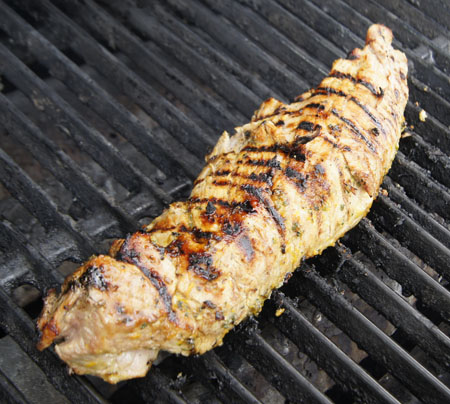 Yum! This was perfect! Moist and flavorful with great grill marks. I served it with a green salad and corn on the cob for a light, healthy, tasty meal.
Yum! This was perfect! Moist and flavorful with great grill marks. I served it with a green salad and corn on the cob for a light, healthy, tasty meal.
Thank you, Cook’s Illustrated, for another great recipe.
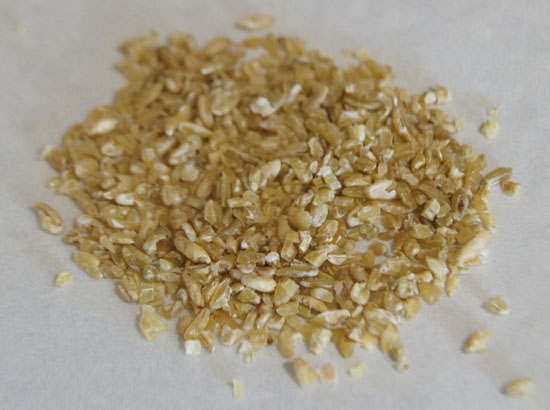 For a size comparison, freekeh next to medium brown rice:
For a size comparison, freekeh next to medium brown rice: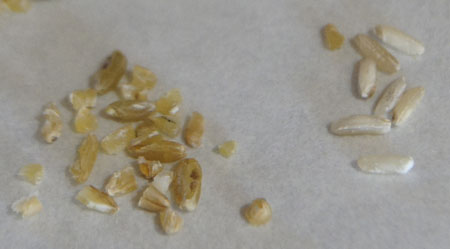
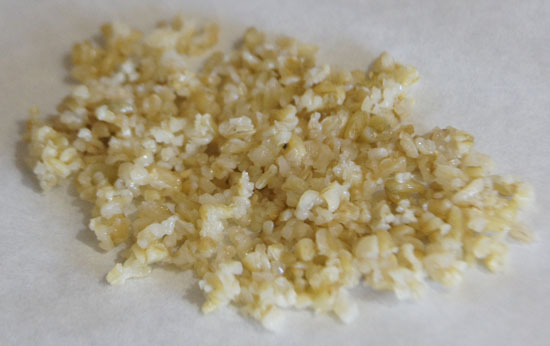

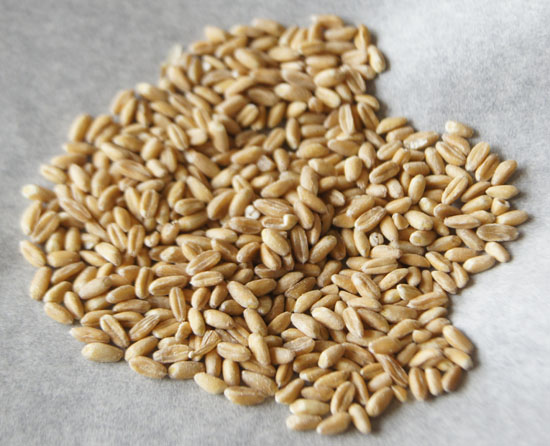 Here it is next to grains of medium brown rice, to show you the size:
Here it is next to grains of medium brown rice, to show you the size: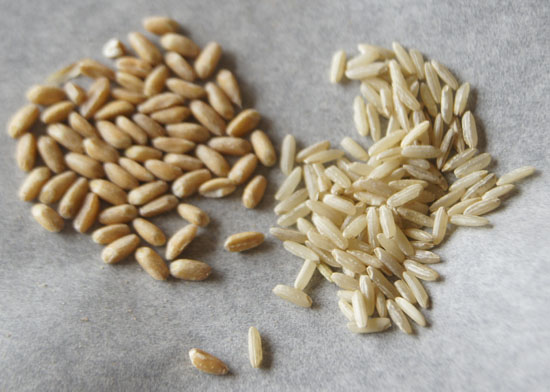

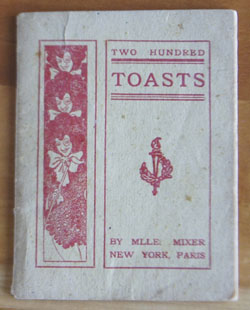
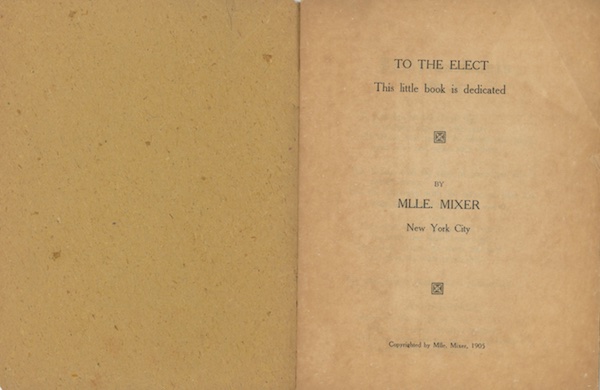


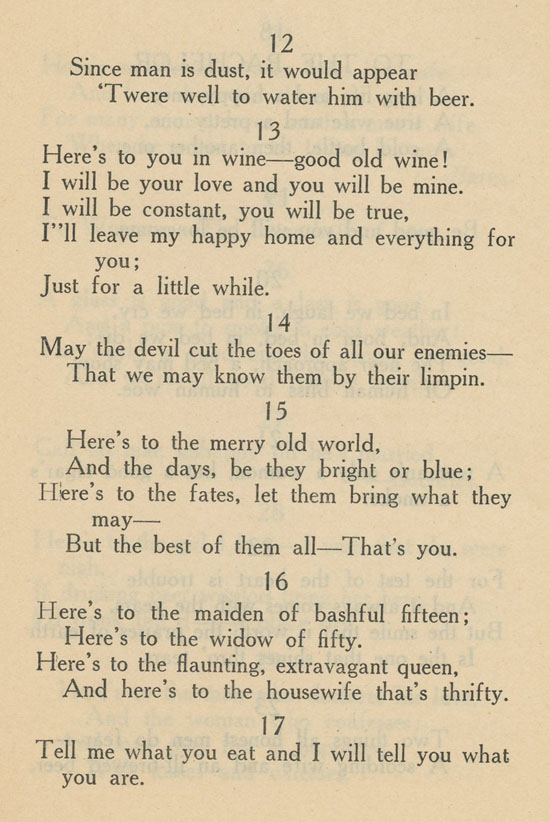 “Be good and you will be lonesome.”
“Be good and you will be lonesome.” Oh my! Such an attitude: “To Woman: the bitter half of man” and “Call no man unhappy till he’s married.”
Oh my! Such an attitude: “To Woman: the bitter half of man” and “Call no man unhappy till he’s married.”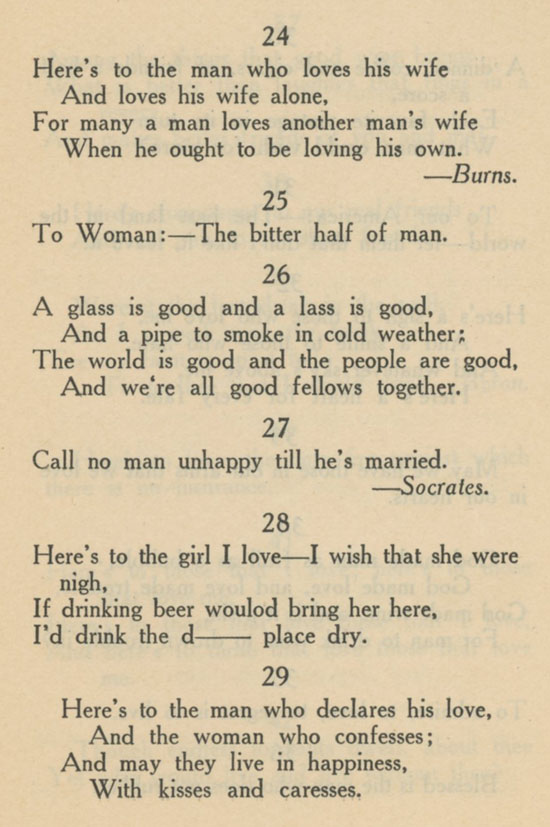 “To our America: The best land in the world – let them that don’t like it, leave it.”
“To our America: The best land in the world – let them that don’t like it, leave it.” “Among the things that good wine brings, what is better than laughter that rings in a revery and makes better friends of you and me!” I like the one about champagne too.
“Among the things that good wine brings, what is better than laughter that rings in a revery and makes better friends of you and me!” I like the one about champagne too. “Good liquor, I stoutly maintain, gives learning a better discerning!”
“Good liquor, I stoutly maintain, gives learning a better discerning!” “Tis easy enough to be pleasant, when life goes by with a song; but the man worth while is the man who will smile when everything goes dead wrong.”
“Tis easy enough to be pleasant, when life goes by with a song; but the man worth while is the man who will smile when everything goes dead wrong.”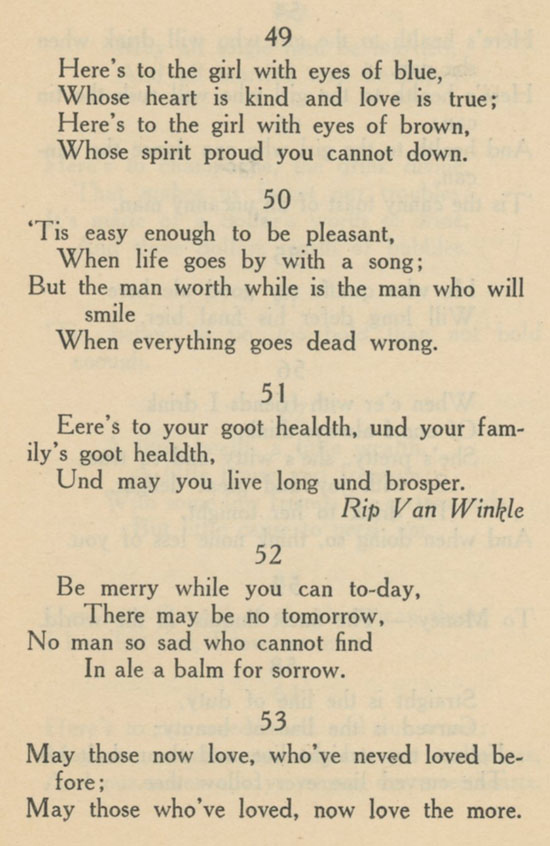 “Here’s health to the girl who will drink when she can, and health to the girl who can dance the can-can.”
“Here’s health to the girl who will drink when she can, and health to the girl who can dance the can-can.”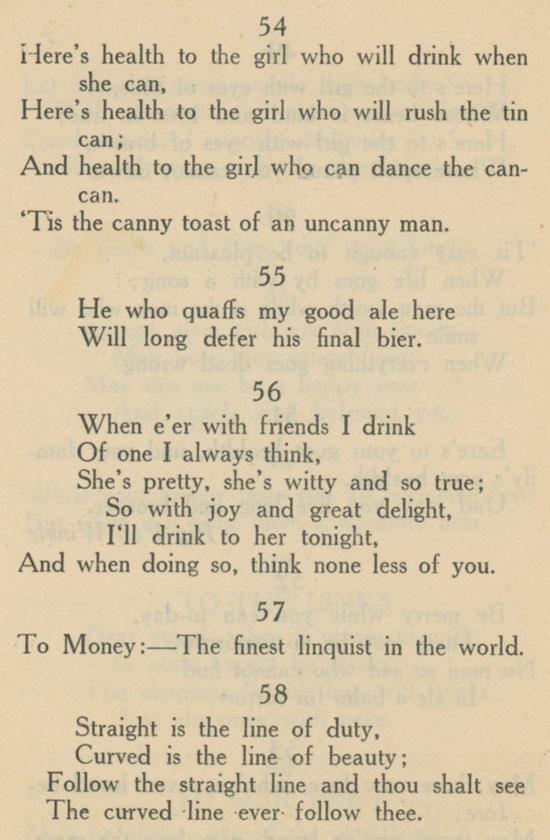 “Here’s to champagne, the drink divine, that makes us forget our troubles; it’s made of a dollar’s worth of wine, and three dollars worth of bubbles.”
“Here’s to champagne, the drink divine, that makes us forget our troubles; it’s made of a dollar’s worth of wine, and three dollars worth of bubbles.”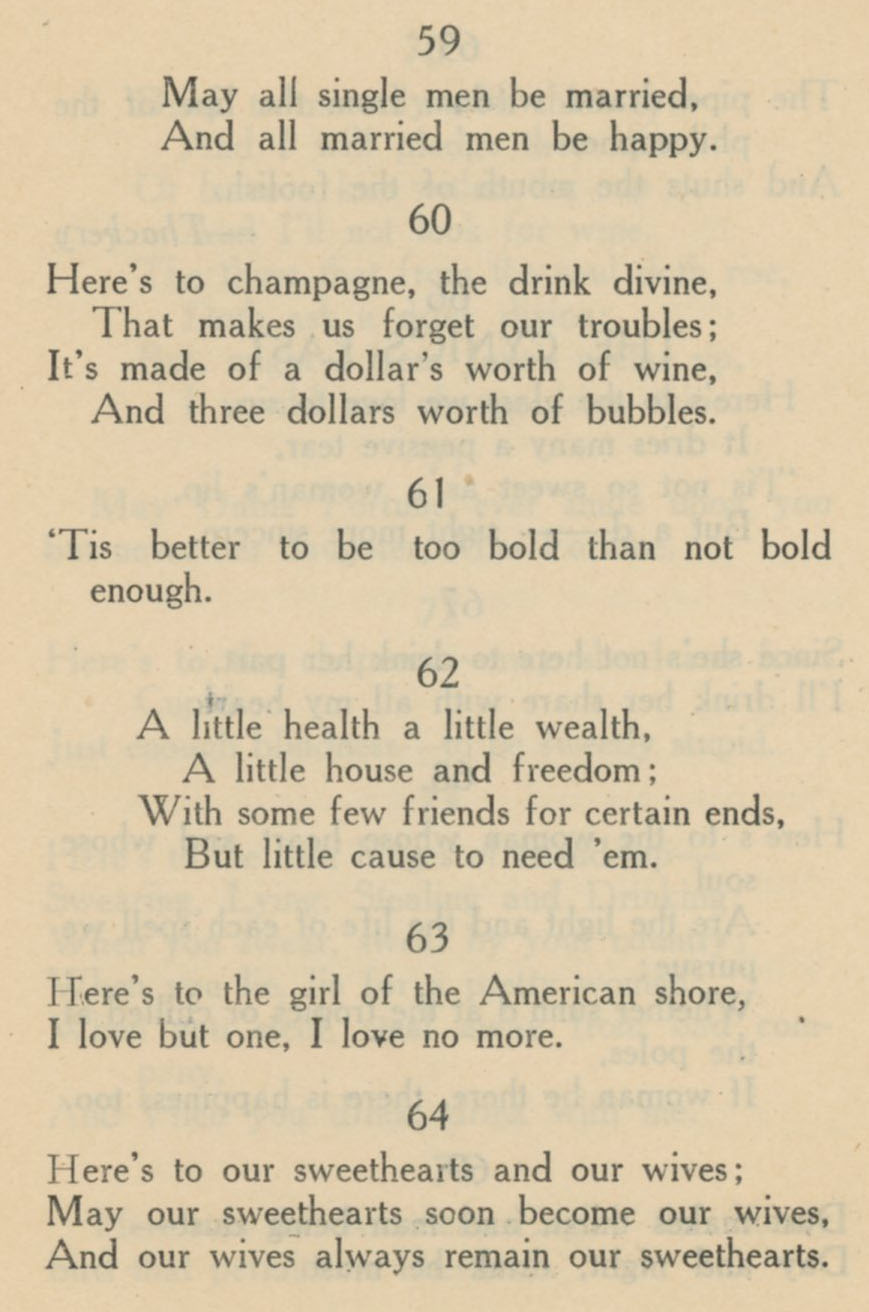 “Since she’s not here to drink her part, I’ll drink her share with all my heart.”
“Since she’s not here to drink her part, I’ll drink her share with all my heart.”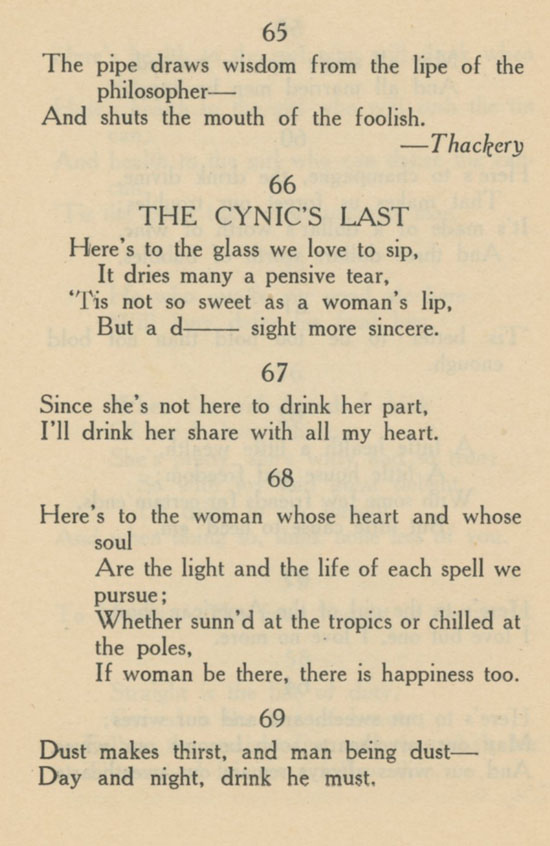 “May Dame Fortune ever smile upon you but never her daughter, Miss fortune.” And also: “Here’s to the chaperone – may she learn from Cupid. Just enough blindness – to be sweetly stupid.”
“May Dame Fortune ever smile upon you but never her daughter, Miss fortune.” And also: “Here’s to the chaperone – may she learn from Cupid. Just enough blindness – to be sweetly stupid.”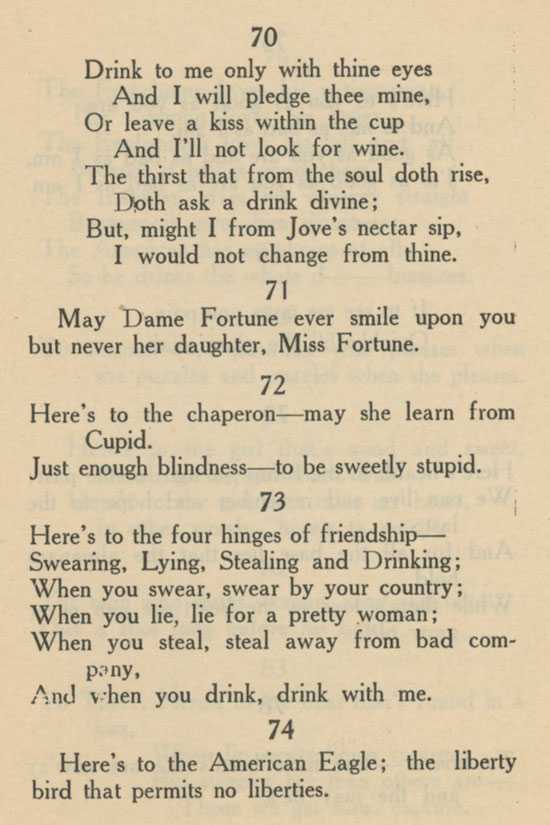
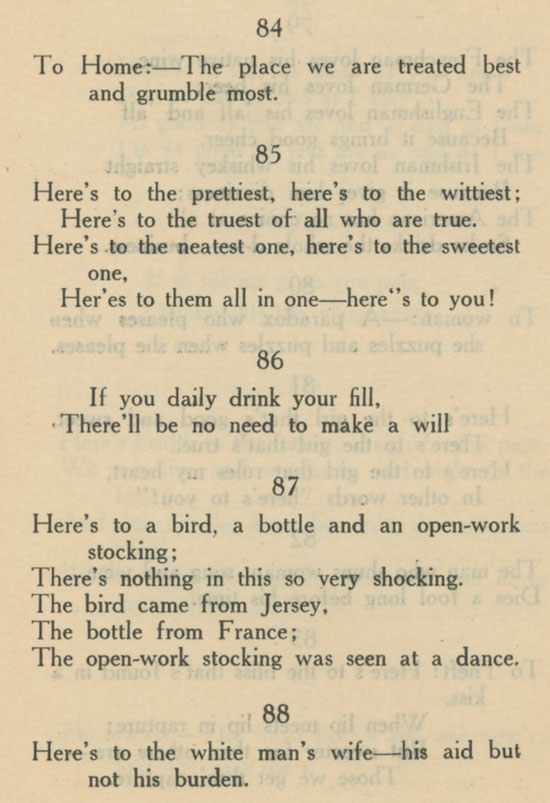
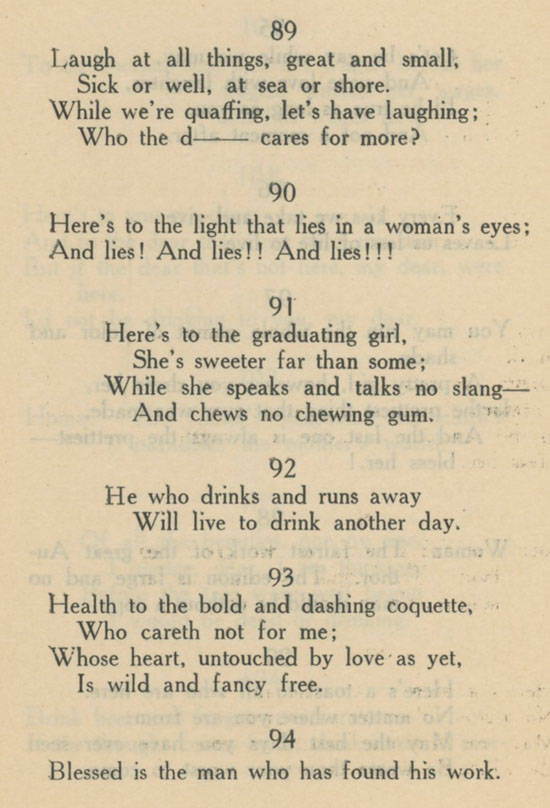
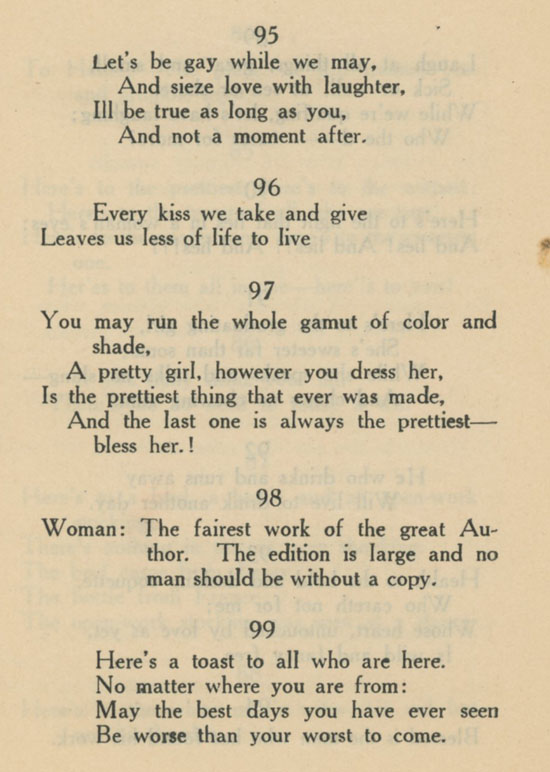 “Drink beer and forget your sorrow; if the thought comes back, drink more to morrow.” I also like number 100, about the servant and her wages.
“Drink beer and forget your sorrow; if the thought comes back, drink more to morrow.” I also like number 100, about the servant and her wages. “While beer brings gladness, don’t forget that water only makes you wet.”
“While beer brings gladness, don’t forget that water only makes you wet.”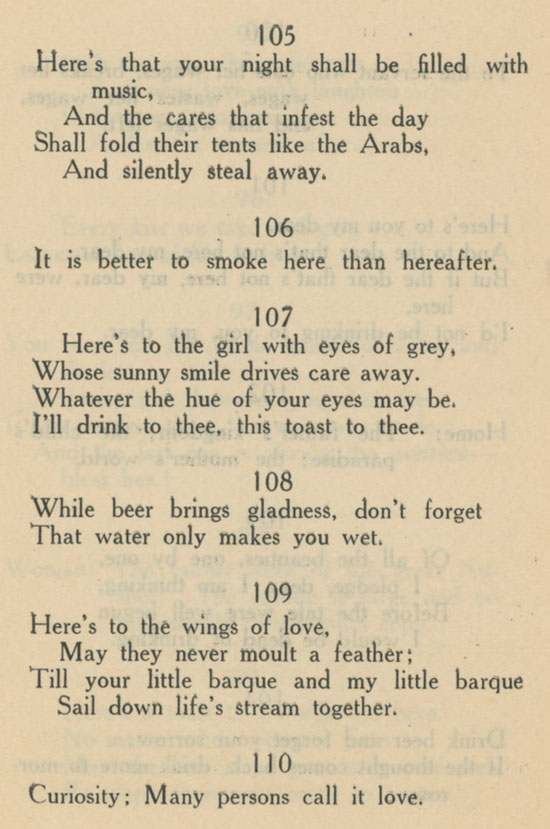 “The health of those we love best – ourselves.”
“The health of those we love best – ourselves.”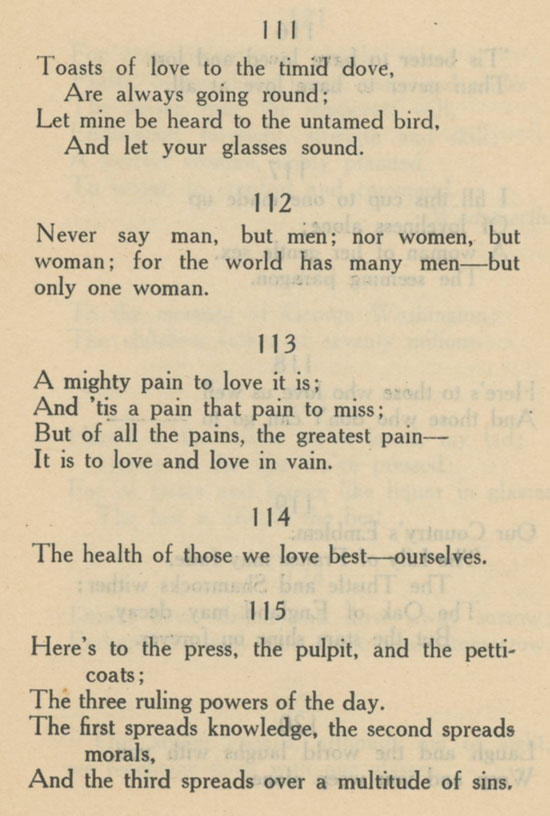 The classic: “Tis better to have loved and lost than never to have love at all.”
The classic: “Tis better to have loved and lost than never to have love at all.” “Our absent friends, although out of sight, we recognize them with our glasses.”
“Our absent friends, although out of sight, we recognize them with our glasses.” “Woman: Gentle, patient, self-denying. Without her man would be a savage and the earth a desert.”
“Woman: Gentle, patient, self-denying. Without her man would be a savage and the earth a desert.”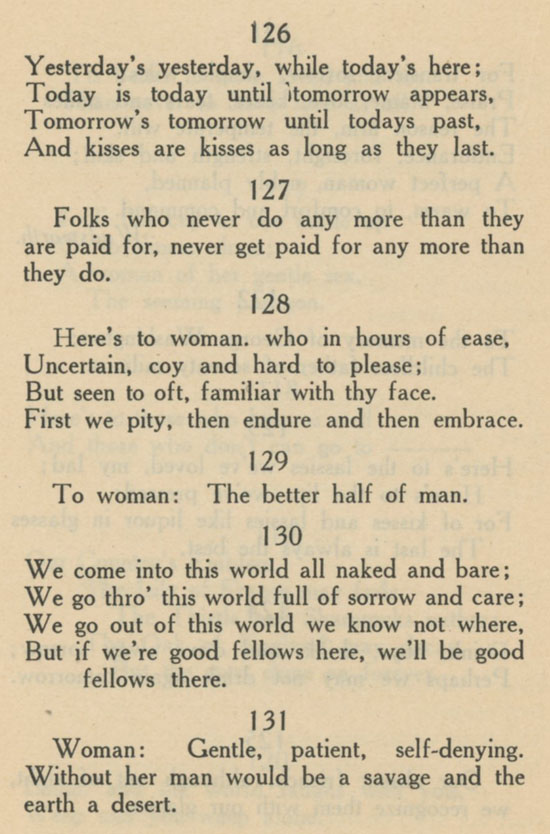 “Fill the bowl with flowing wine, and while your lips are wet, press their fragrance unto mine, and forget!!!!”
“Fill the bowl with flowing wine, and while your lips are wet, press their fragrance unto mine, and forget!!!!”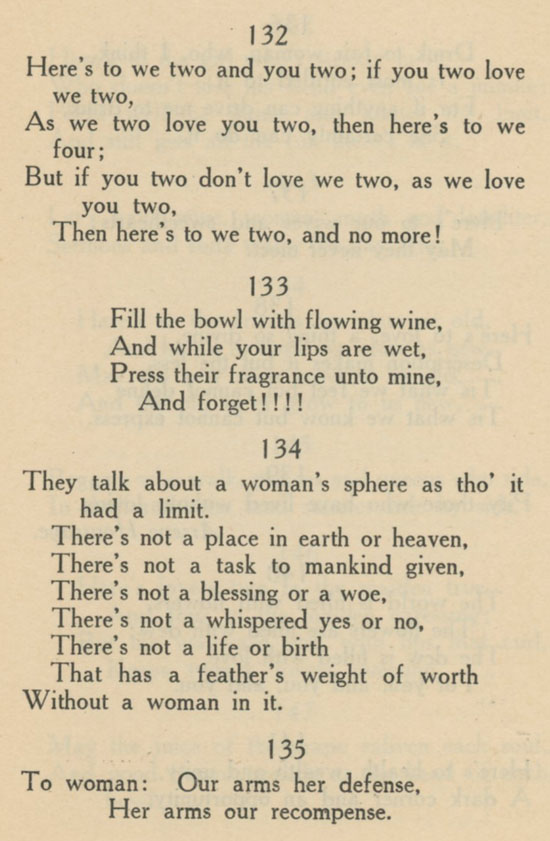 “Here’s to our wives and sweethearts; may they never meet.”
“Here’s to our wives and sweethearts; may they never meet.”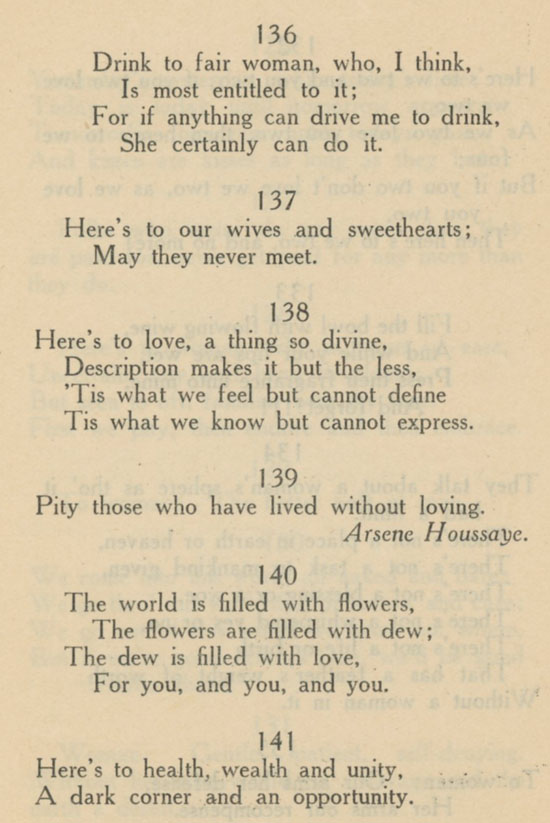 “Let’s have wine, women, mirth and laughter, sermons and soda water the day after.”
“Let’s have wine, women, mirth and laughter, sermons and soda water the day after.”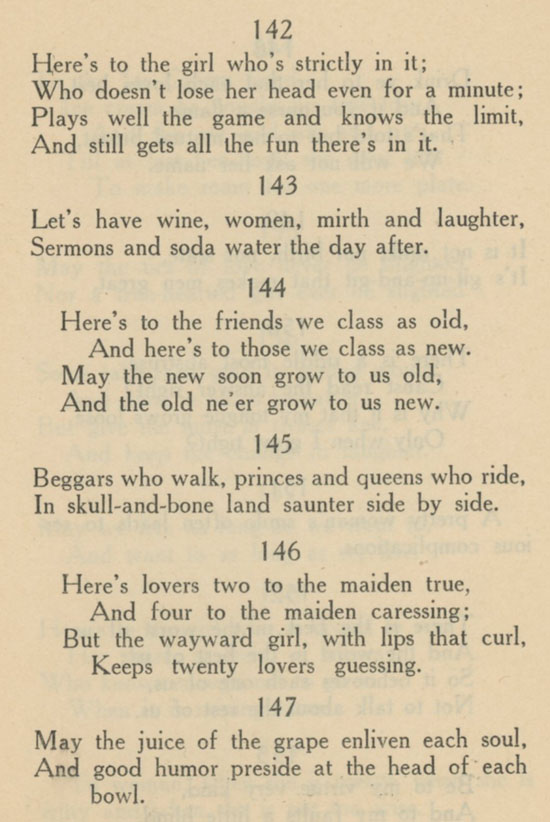
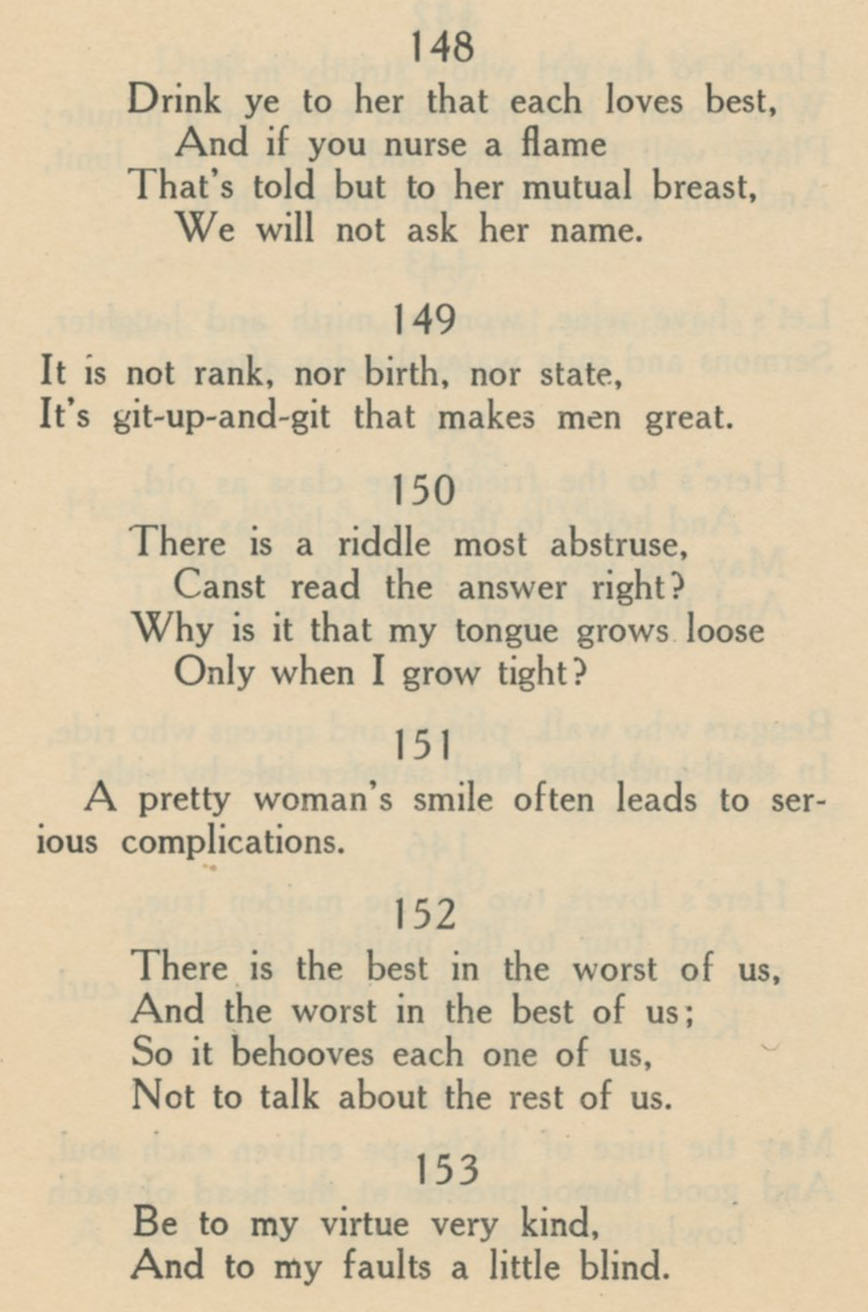 May we live as long as we want to, and want to as long as we live.”
May we live as long as we want to, and want to as long as we live.”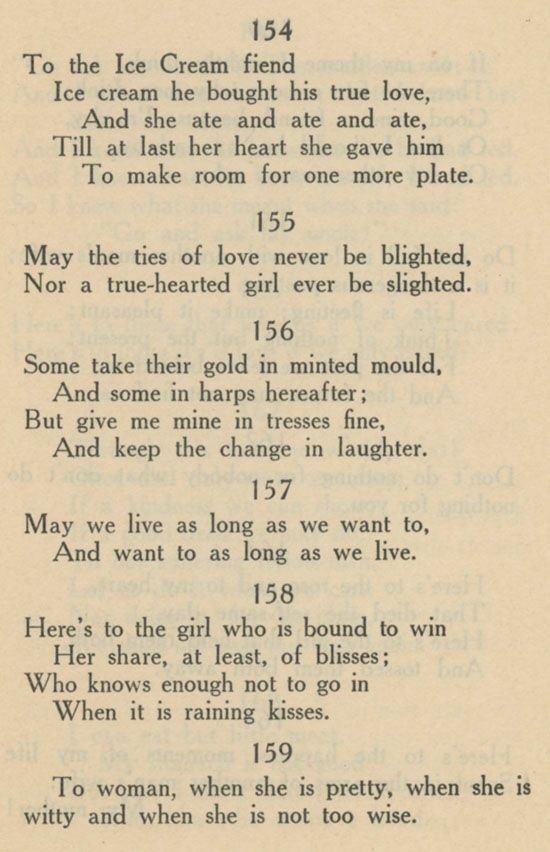 “Don’t do nothing for nobody what don’t do nothing for you.”
“Don’t do nothing for nobody what don’t do nothing for you.”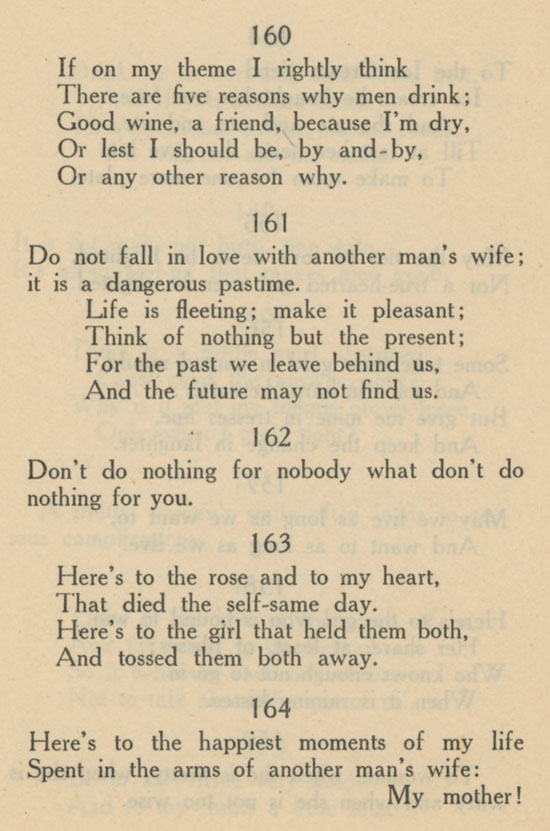 I like number 167, that ends: “We shall not pass this way again.”
I like number 167, that ends: “We shall not pass this way again.”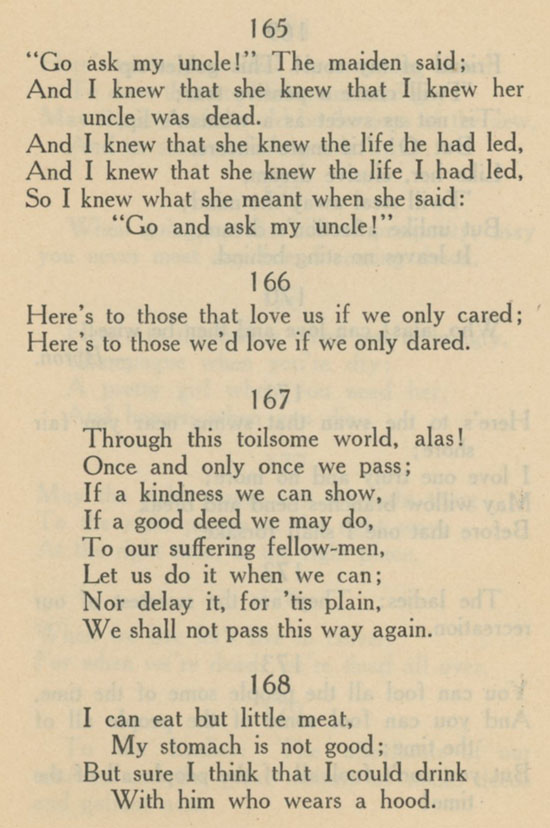 “You can fool all the people some of the time, and you can fool some of the people all of the time; but you can’t fool all of the people all of the time!”
“You can fool all the people some of the time, and you can fool some of the people all of the time; but you can’t fool all of the people all of the time!”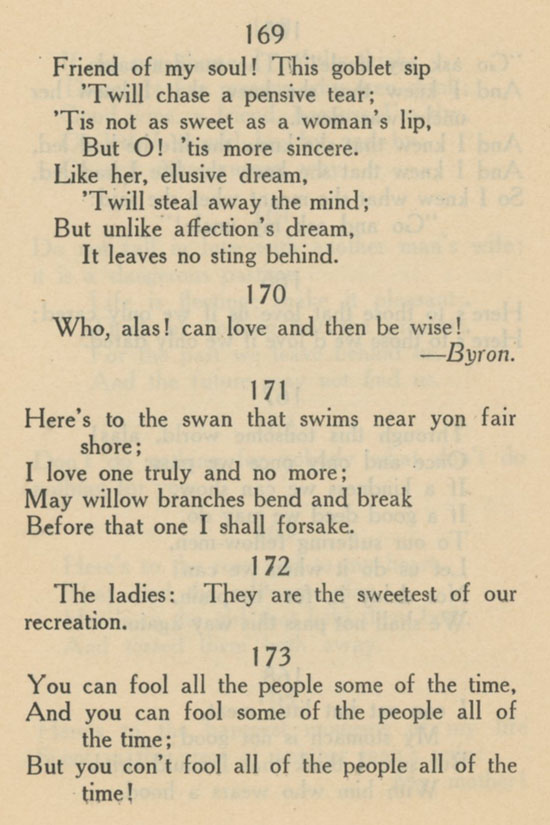 “When going up the hill of prosperity, may you never meet any friend coming down.”
“When going up the hill of prosperity, may you never meet any friend coming down.”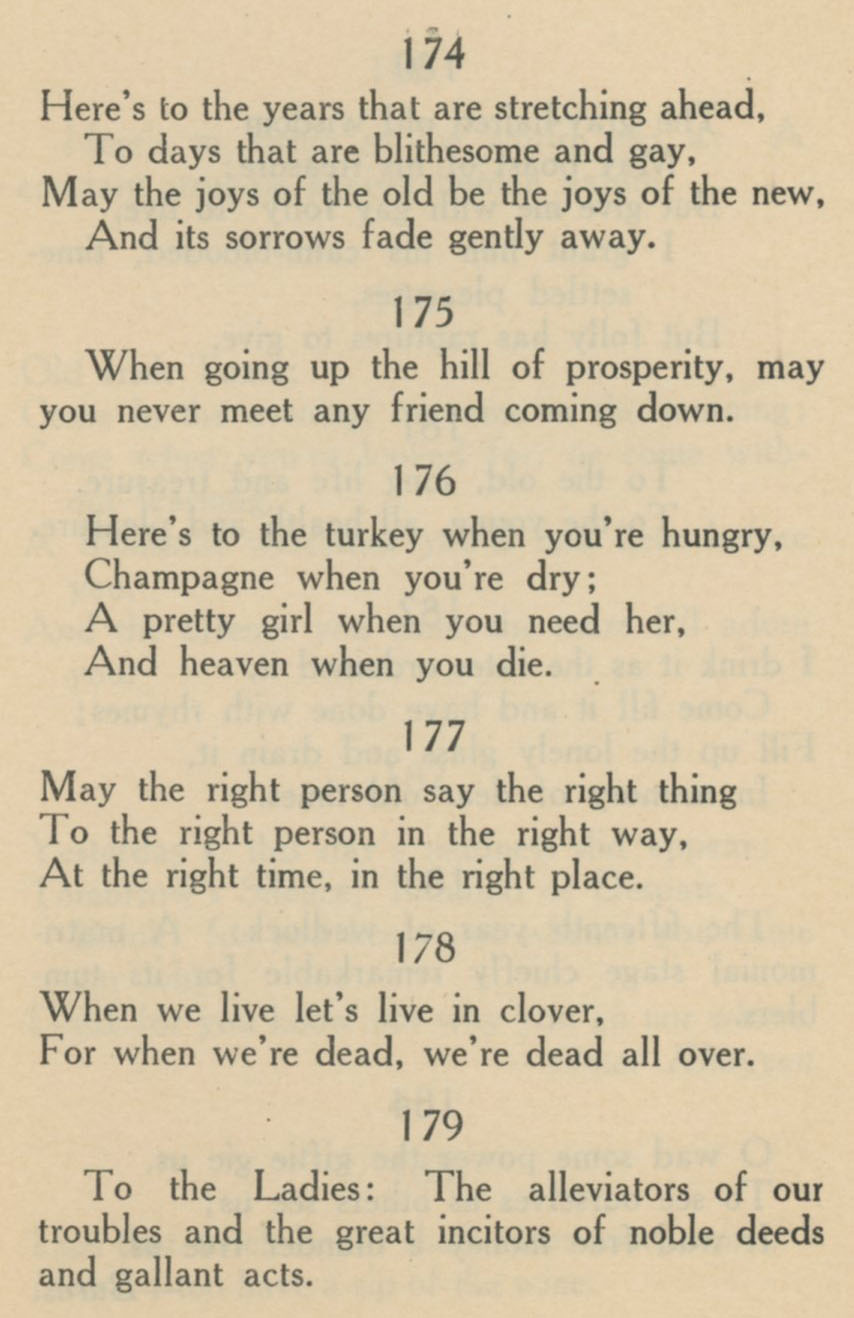 “To the old, long life and treasure. To the young, all health and pleasure.”
“To the old, long life and treasure. To the young, all health and pleasure.” “Here’s to virtue as the world sees it: A constant struggle against human nature.” And “Lips that touch liquor shall never touch mine, unless I too have a sip of the wine.”
“Here’s to virtue as the world sees it: A constant struggle against human nature.” And “Lips that touch liquor shall never touch mine, unless I too have a sip of the wine.”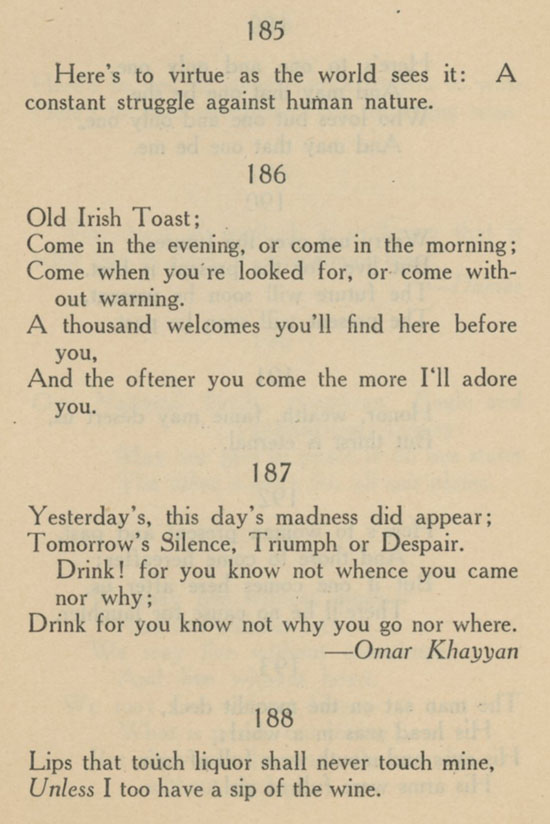 “Honor, wealth, fame may desert us, but thirst is eternal.”
“Honor, wealth, fame may desert us, but thirst is eternal.” “Here’s to you in water, here’s to you in wine, here’s to your sweetheart, not forgetting mine.”
“Here’s to you in water, here’s to you in wine, here’s to your sweetheart, not forgetting mine.”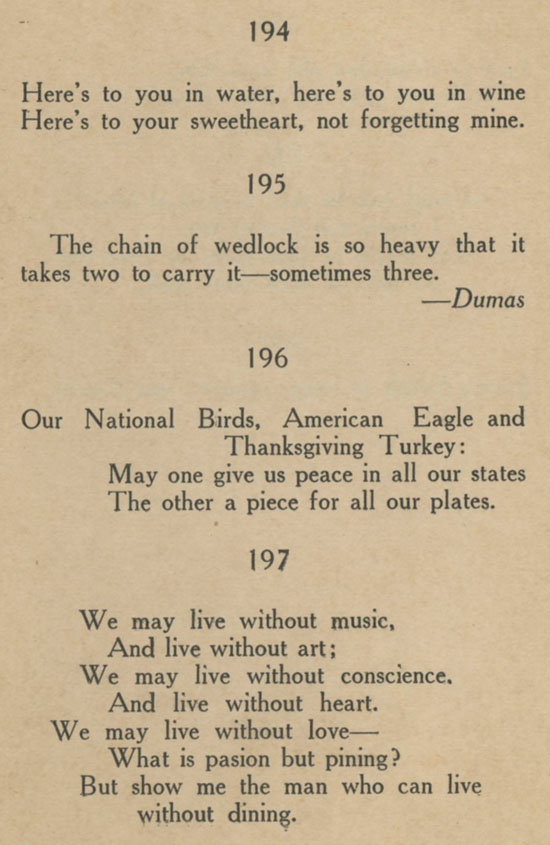 “Love is sweet, but oh! how bitter to love a girl, and then not git her.”
“Love is sweet, but oh! how bitter to love a girl, and then not git her.” And so we come to the end of Two Hundred Toasts by Mlle. Mixer. I hope you found a few toasts that you liked.
And so we come to the end of Two Hundred Toasts by Mlle. Mixer. I hope you found a few toasts that you liked. My second-to-last cookbook in this 250 Cookbooks blog! Hard to believe this 5-year project is coming to an end.
My second-to-last cookbook in this 250 Cookbooks blog! Hard to believe this 5-year project is coming to an end. Yum! This was perfect! Moist and flavorful with great grill marks. I served it with a green salad and corn on the cob for a light, healthy, tasty meal.
Yum! This was perfect! Moist and flavorful with great grill marks. I served it with a green salad and corn on the cob for a light, healthy, tasty meal. Pillsbury’s Bake Off Dessert Cook Book is the last and grandest of my Pillsbury Bake-Off cookbooks. All of the others are small booklets but this one is hard-cover bound and 144 pages long. It includes recipes from “Eighteen years of Pillsbury Bake Offs”, updated with “short-cuts and the use of convenience food ingredients where possible”. (I discuss Pillsbury Bake-off cookbooks/recipe magazines more thoroughly in my blog post covering the
Pillsbury’s Bake Off Dessert Cook Book is the last and grandest of my Pillsbury Bake-Off cookbooks. All of the others are small booklets but this one is hard-cover bound and 144 pages long. It includes recipes from “Eighteen years of Pillsbury Bake Offs”, updated with “short-cuts and the use of convenience food ingredients where possible”. (I discuss Pillsbury Bake-off cookbooks/recipe magazines more thoroughly in my blog post covering the 
 These were excellent. Except for the crust, they aren’t terribly rich. The next night, I made another batch of the cherry mixture and served them with ice cream. Yum!
These were excellent. Except for the crust, they aren’t terribly rich. The next night, I made another batch of the cherry mixture and served them with ice cream. Yum!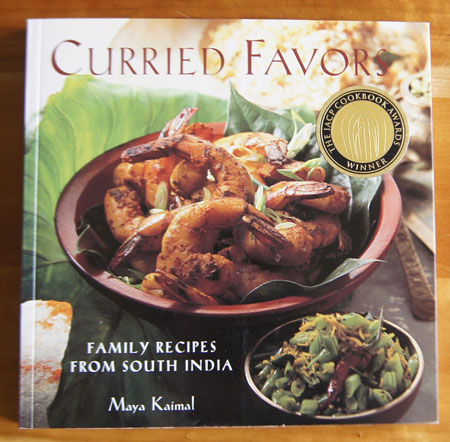
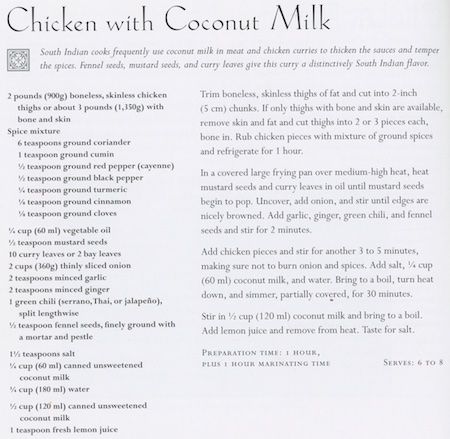 I plan to cut the recipe in half and leave out the turmeric, and use less cayenne. I have everything for this recipe in my pantry and or my freezer except the coconut milk and a fresh hot chili (a quick trip to a store solved those issues). I will use bay leaves instead of curry (or kari) leaves. (I know where to find curry leaves in downtown Boulder, but don’t have any in my pantry right now.} I also increased the amount of coconut milk. Below is my adaptation of the above recipe.
I plan to cut the recipe in half and leave out the turmeric, and use less cayenne. I have everything for this recipe in my pantry and or my freezer except the coconut milk and a fresh hot chili (a quick trip to a store solved those issues). I will use bay leaves instead of curry (or kari) leaves. (I know where to find curry leaves in downtown Boulder, but don’t have any in my pantry right now.} I also increased the amount of coconut milk. Below is my adaptation of the above recipe. When the chicken has rested in its rub (refrigerated) for at least an hour, set a frying pan on medium high heat and add the oil, mustard seeds, and bay leaf. Cover. Heat until the mustard seeds pop. Uncover and add the onion and cook and stir until the onion is browning nicely. Add the garlic, ginger, green chili, and ground fennel seeds and cook and stir for 2 minutes.
When the chicken has rested in its rub (refrigerated) for at least an hour, set a frying pan on medium high heat and add the oil, mustard seeds, and bay leaf. Cover. Heat until the mustard seeds pop. Uncover and add the onion and cook and stir until the onion is browning nicely. Add the garlic, ginger, green chili, and ground fennel seeds and cook and stir for 2 minutes.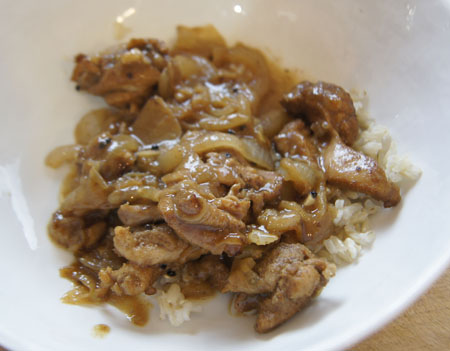 I love this curry. I like the whole cooking process, too. The aromas as it cooks! The flavors as I eat it! But hubby? Well, he ate it all. But when asked, he said something like “yeah, it was dinner”. Guess I didn’t slip this curry by him. Maybe it isn’t just the yellow color that he does not like about curries. His loss.
I love this curry. I like the whole cooking process, too. The aromas as it cooks! The flavors as I eat it! But hubby? Well, he ate it all. But when asked, he said something like “yeah, it was dinner”. Guess I didn’t slip this curry by him. Maybe it isn’t just the yellow color that he does not like about curries. His loss.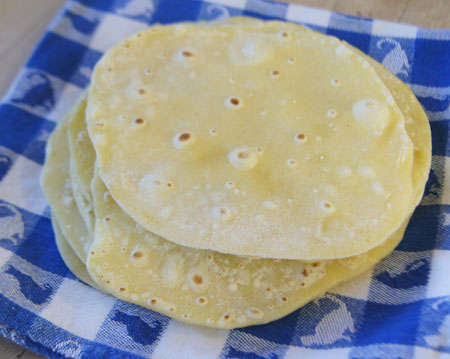 I also made chappathi from another recipe in this book. These are small flatbreads cooked on a stove-top, similar to tortillas, but made from durum wheat flour (“atta” flour) and water (and a little salt) – that’s all. I had some durum wheat flour in my pantry because of forays into pasta cooking. To make the chappathi, you mix and knead together flour and water, cut into equal-sized pieces, roll each to a circle, and cook briefly on a hot griddle. It’s kind of like making tortillas or crepes or pita breads. Mine came out pretty good. Here’s the rolled out dough:
I also made chappathi from another recipe in this book. These are small flatbreads cooked on a stove-top, similar to tortillas, but made from durum wheat flour (“atta” flour) and water (and a little salt) – that’s all. I had some durum wheat flour in my pantry because of forays into pasta cooking. To make the chappathi, you mix and knead together flour and water, cut into equal-sized pieces, roll each to a circle, and cook briefly on a hot griddle. It’s kind of like making tortillas or crepes or pita breads. Mine came out pretty good. Here’s the rolled out dough:
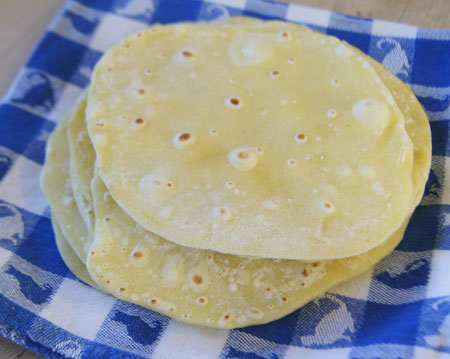 Taste? Not a lot, but I thought they were interesting. They sure are cute.
Taste? Not a lot, but I thought they were interesting. They sure are cute.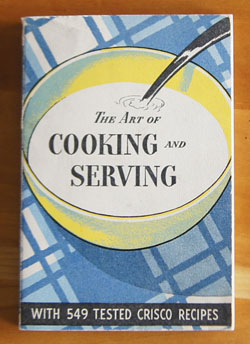
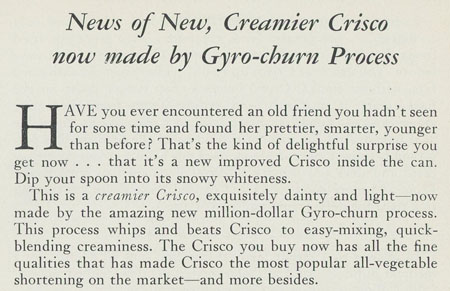 Next come four chapters that discuss the proper way to manage a kitchen and serve food. Transport yourself back 81 years, to the kitchen of my grandmother, to the culture of America in the 1930s. Here is the beginning of the first chapter:
Next come four chapters that discuss the proper way to manage a kitchen and serve food. Transport yourself back 81 years, to the kitchen of my grandmother, to the culture of America in the 1930s. Here is the beginning of the first chapter: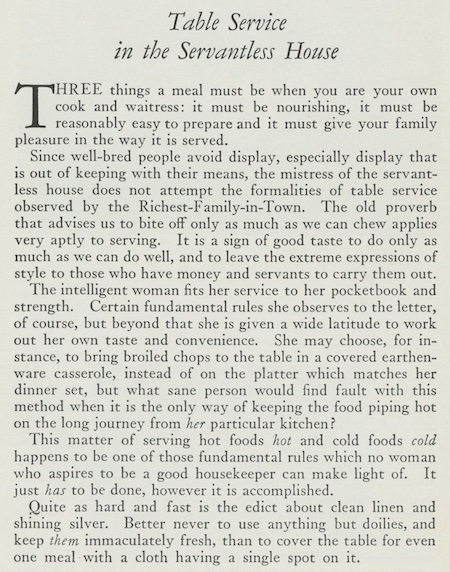
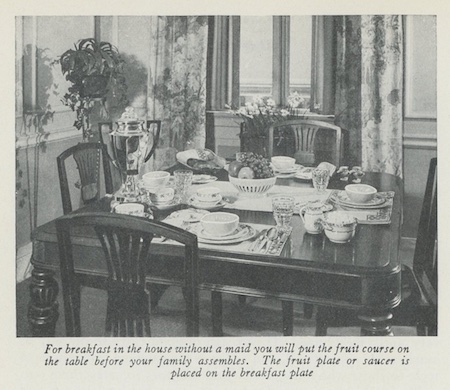 This chapter goes on for 24 pages describing the proper way to serve food in the servantless home. And if you have a maid? That chapter has 9 pages, beginning with these paragraphs:
This chapter goes on for 24 pages describing the proper way to serve food in the servantless home. And if you have a maid? That chapter has 9 pages, beginning with these paragraphs: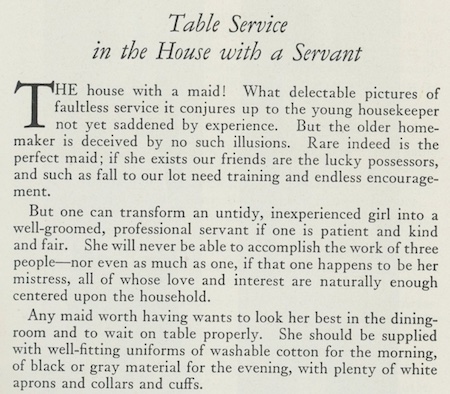
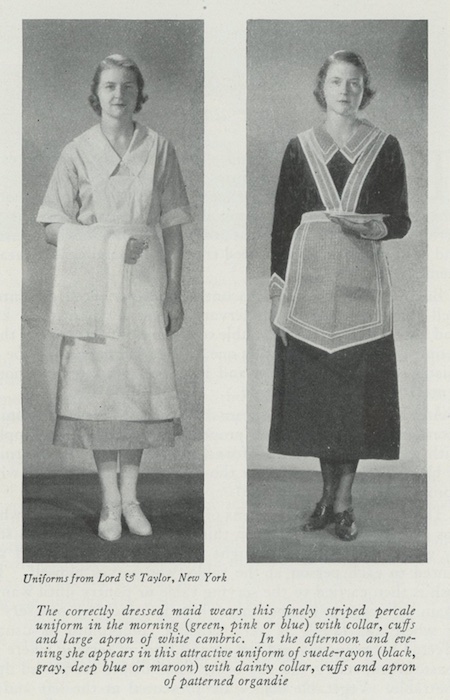
 “How to Plan Your Meals” is a short chapter on what foods to include in your diet for sufficient protein, energy (fats, starches, sugars), body regulation (roughage and minerals), vitamins, and water.
“How to Plan Your Meals” is a short chapter on what foods to include in your diet for sufficient protein, energy (fats, starches, sugars), body regulation (roughage and minerals), vitamins, and water.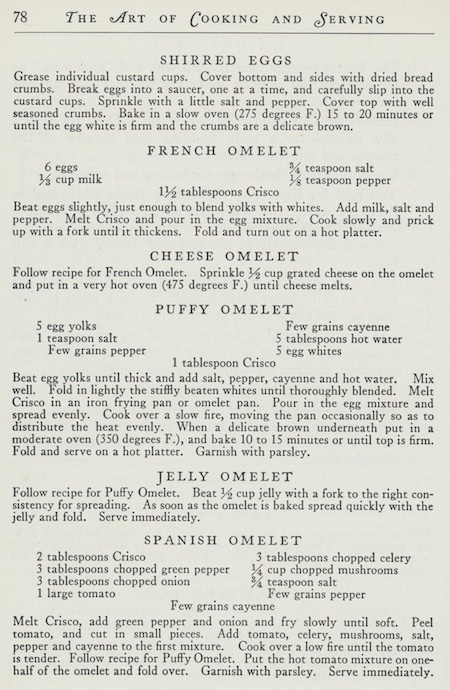 Here is a photo of the omelet:
Here is a photo of the omelet: These recipes are for main dishes.
These recipes are for main dishes.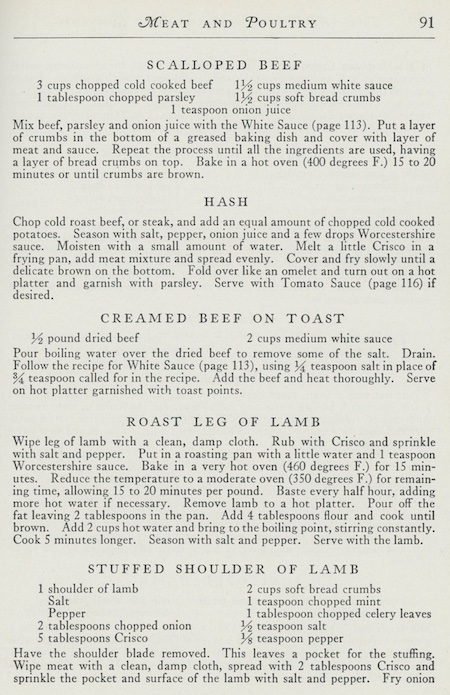 These are classic cookie recipes, especially the Hermits (a dark spice cookie filled with fruits and nuts) and the Oatmeal Cookies.
These are classic cookie recipes, especially the Hermits (a dark spice cookie filled with fruits and nuts) and the Oatmeal Cookies.
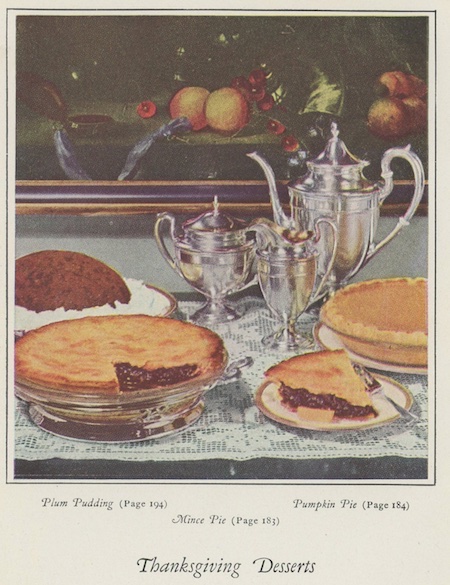
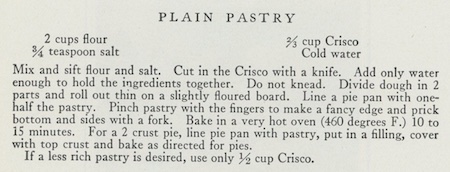 And what type of pie to make with the plain pastry crust? Why not old-fashioned Mincemeat Pie, or Mock Cherry Pie:
And what type of pie to make with the plain pastry crust? Why not old-fashioned Mincemeat Pie, or Mock Cherry Pie: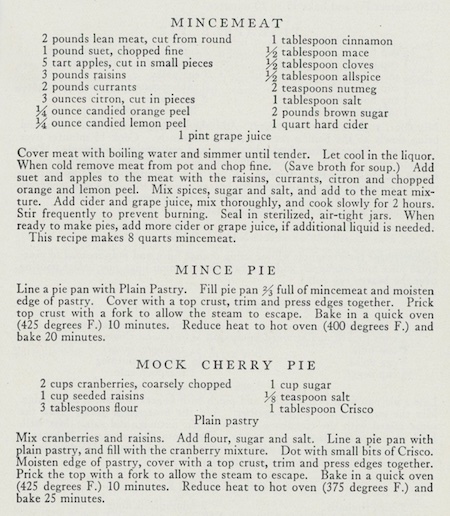
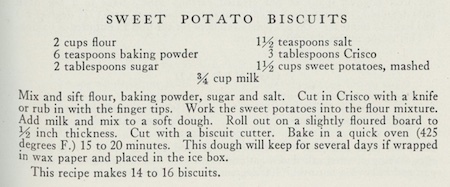 I think this is an amazing recipe. For one, it calls for 1 1/2 cups of sweet potatoes – and that’s a lot! And it calls for only 2 tablespoons of sugar and 3 of shortening. I think the 2 tablespoons baking powder might be a bit much, but I stayed with that original amount. I am going to use my immersion blender to mash the sweet potatoes with the milk, and my food processor for the flour and shortening. Otherwise, I am staying with the original recipe.
I think this is an amazing recipe. For one, it calls for 1 1/2 cups of sweet potatoes – and that’s a lot! And it calls for only 2 tablespoons of sugar and 3 of shortening. I think the 2 tablespoons baking powder might be a bit much, but I stayed with that original amount. I am going to use my immersion blender to mash the sweet potatoes with the milk, and my food processor for the flour and shortening. Otherwise, I am staying with the original recipe.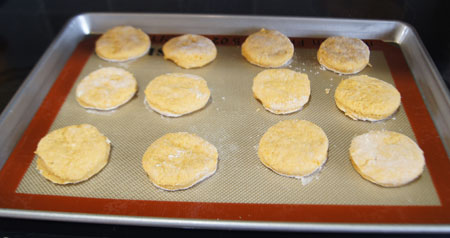 Here they are, baked:
Here they are, baked: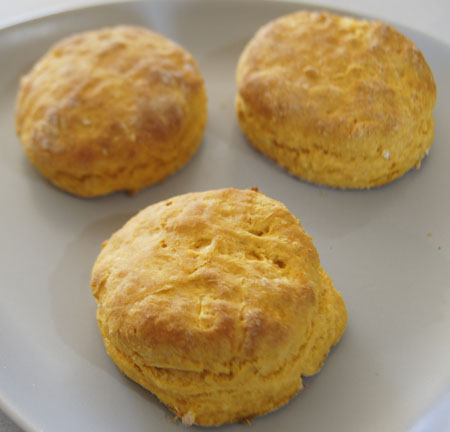
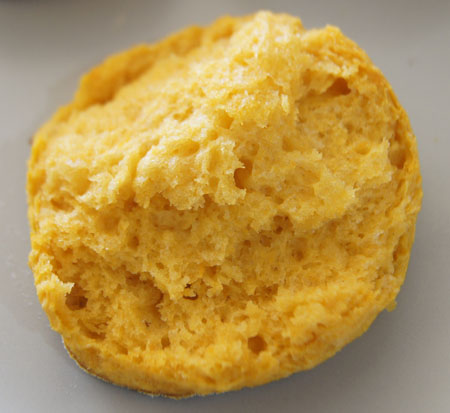 My daughter and I really loved these. Hubby avoided them – he isn’t a sweet potato fan. His loss. And more for us! This was definitely a successful recipe.
My daughter and I really loved these. Hubby avoided them – he isn’t a sweet potato fan. His loss. And more for us! This was definitely a successful recipe.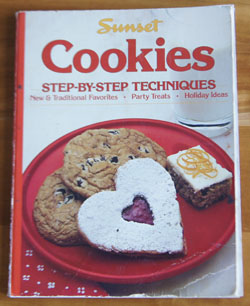 I’ve saved this book for one of my last entries for this 250 Cookbooks blog because it is special to me. It was my mother’s, given to her by my brother and sister in 1986. Her notes are in it, some pages are stained with food, and many pages are falling out of the binding. I just love it!
I’ve saved this book for one of my last entries for this 250 Cookbooks blog because it is special to me. It was my mother’s, given to her by my brother and sister in 1986. Her notes are in it, some pages are stained with food, and many pages are falling out of the binding. I just love it!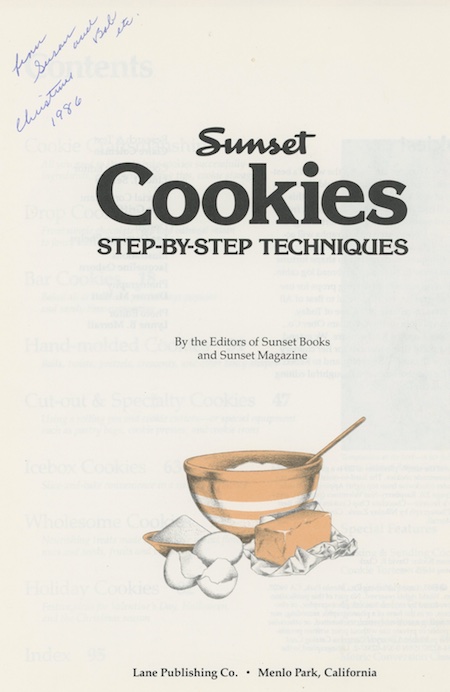
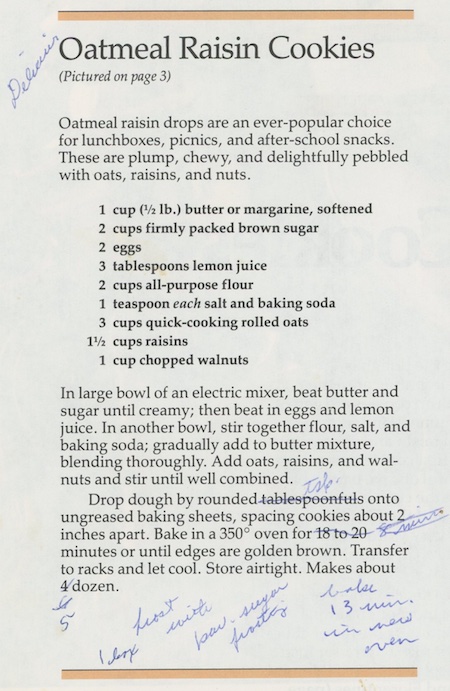
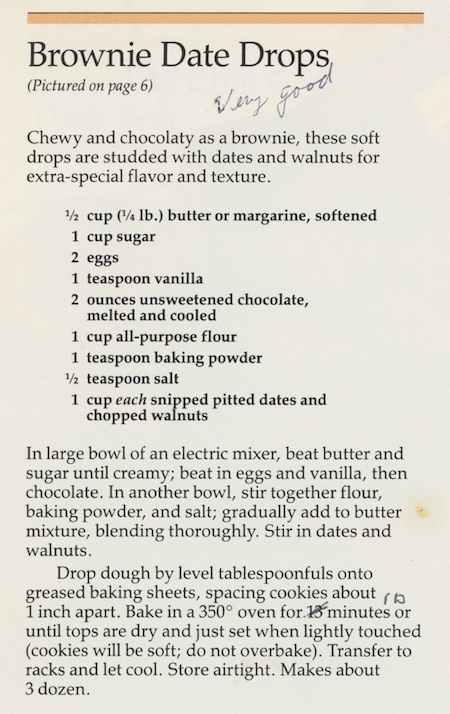
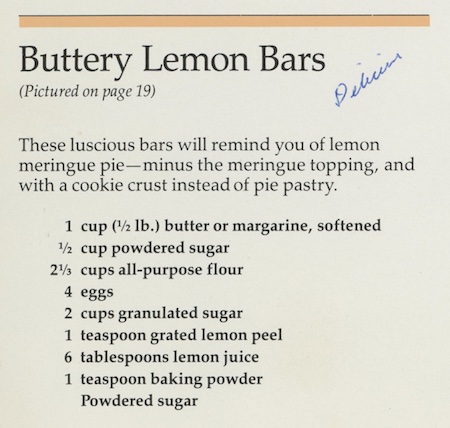

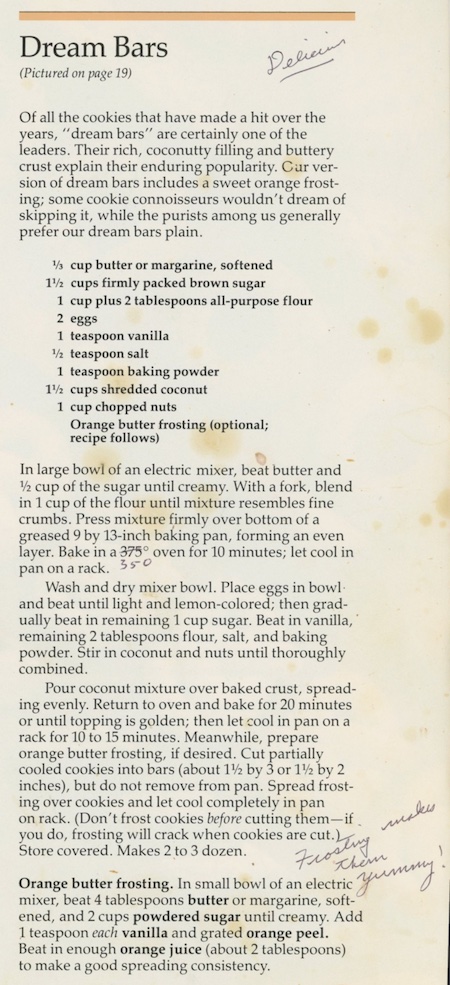
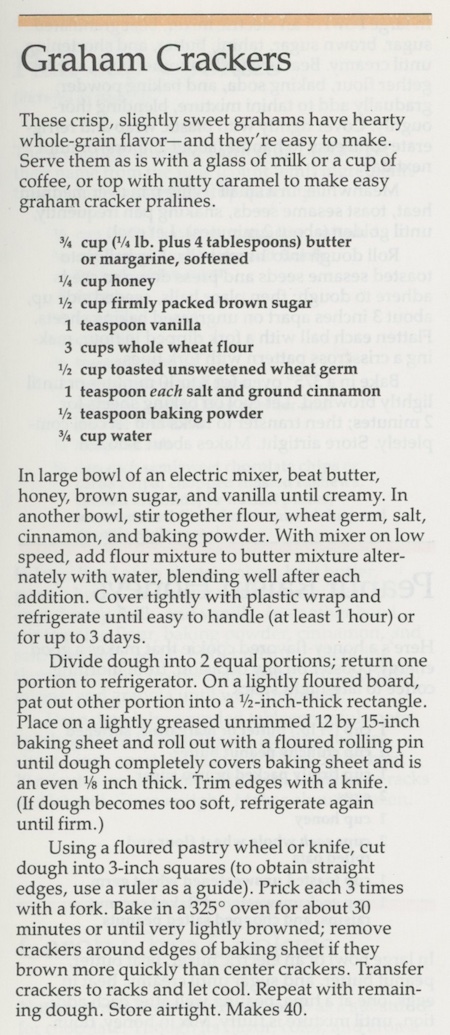
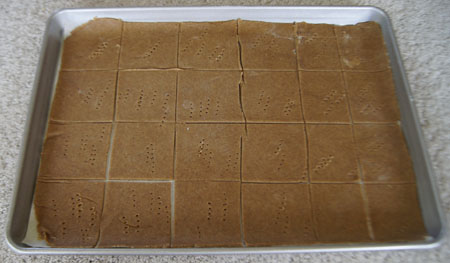 And here is a cooked one on a plate:
And here is a cooked one on a plate: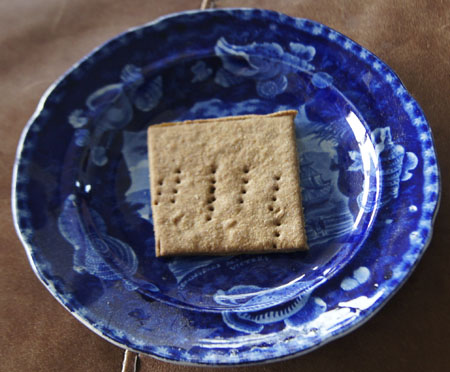 Oh yes, there are not just 3 fork pricks in this cracker! Practicing “one-two-three” with a 4 year old sometimes doesn’t work. But who cares? These were actually delicious, although not all the adults liked them. I thought they were even better the next day, but I doubt the rest of the batch lasted that long – my grandson made sure that he put all his crackers in a bag to take home. I saved this one cracker in the photo above to be sure I had one to take of picture of the next day. Then I ate it!
Oh yes, there are not just 3 fork pricks in this cracker! Practicing “one-two-three” with a 4 year old sometimes doesn’t work. But who cares? These were actually delicious, although not all the adults liked them. I thought they were even better the next day, but I doubt the rest of the batch lasted that long – my grandson made sure that he put all his crackers in a bag to take home. I saved this one cracker in the photo above to be sure I had one to take of picture of the next day. Then I ate it!
 “I smile warmly at Julia Child’s complete love of cooking”. These words were mine when I explored
“I smile warmly at Julia Child’s complete love of cooking”. These words were mine when I explored  From the above excerpt, we learn that Mastering the Art of French Cooking was written as a textbook, a complete guide, and was written as a collaboration. I used to be a bit intimidated by that first tome. (Now I totally enjoy it!) From Julia Child’s Kitchen is less serious and more fun. Sure, it includes all the important methods of preparing soups, poultry, meats, egg dishes, quiches, homemade sausages, fresh vegetables, French breads, pastries and desserts. But it focuses on the American home cook, with recipes that can be made in a reasonable amount of time and with any level of cooking skill. From Julia Child’s Kitchen also has a chapter on “earthy alternatives”, such as lentils, beans and rice. I find most of the recipes a bit less calorie-laden than in her previous book. And, there are cartoons throughout.
From the above excerpt, we learn that Mastering the Art of French Cooking was written as a textbook, a complete guide, and was written as a collaboration. I used to be a bit intimidated by that first tome. (Now I totally enjoy it!) From Julia Child’s Kitchen is less serious and more fun. Sure, it includes all the important methods of preparing soups, poultry, meats, egg dishes, quiches, homemade sausages, fresh vegetables, French breads, pastries and desserts. But it focuses on the American home cook, with recipes that can be made in a reasonable amount of time and with any level of cooking skill. From Julia Child’s Kitchen also has a chapter on “earthy alternatives”, such as lentils, beans and rice. I find most of the recipes a bit less calorie-laden than in her previous book. And, there are cartoons throughout.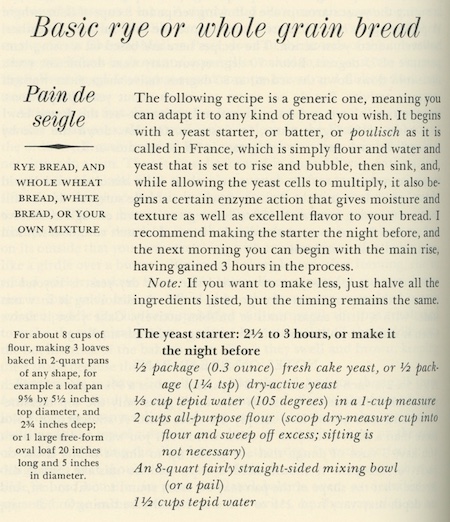
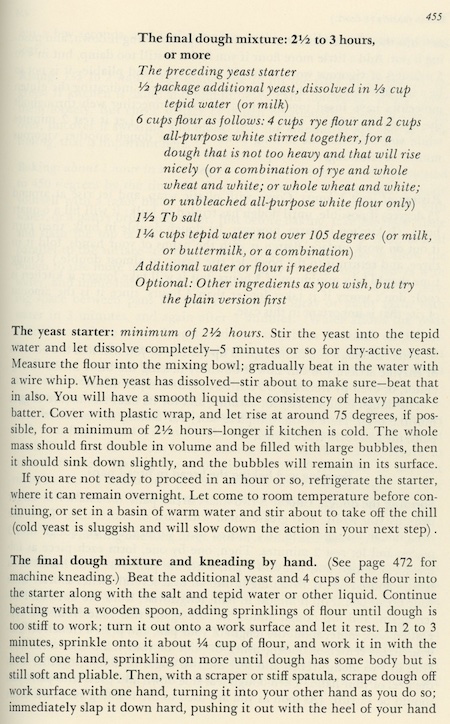

 And in the very back of From Julia Child’s Kitchen I find this – what I call very funny – passage in one of the appendices:
And in the very back of From Julia Child’s Kitchen I find this – what I call very funny – passage in one of the appendices: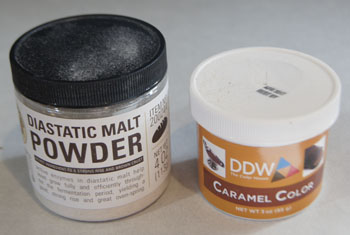
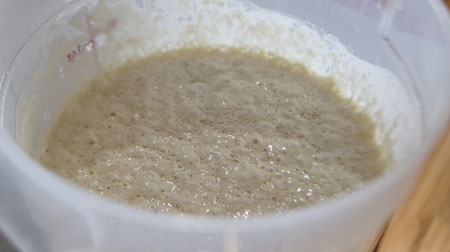 It is just lovely and bubbly and has a wonderful yeasty sour smell.
It is just lovely and bubbly and has a wonderful yeasty sour smell.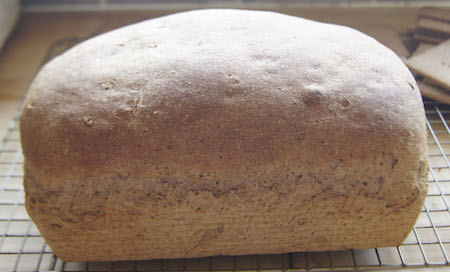
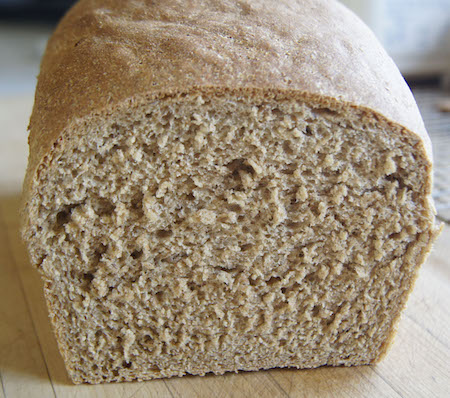
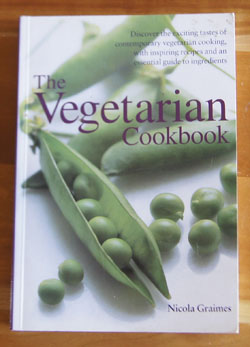 The Vegetarian Cookbook is pleasantly laid out and illustrated, and Nicola Graimes is a personable author. I probably bought this book at a time when my daughter was vegetarian. I don’t think I’ve cooked many – if any – of the recipes in it! Why not? I really can’t tell you.
The Vegetarian Cookbook is pleasantly laid out and illustrated, and Nicola Graimes is a personable author. I probably bought this book at a time when my daughter was vegetarian. I don’t think I’ve cooked many – if any – of the recipes in it! Why not? I really can’t tell you.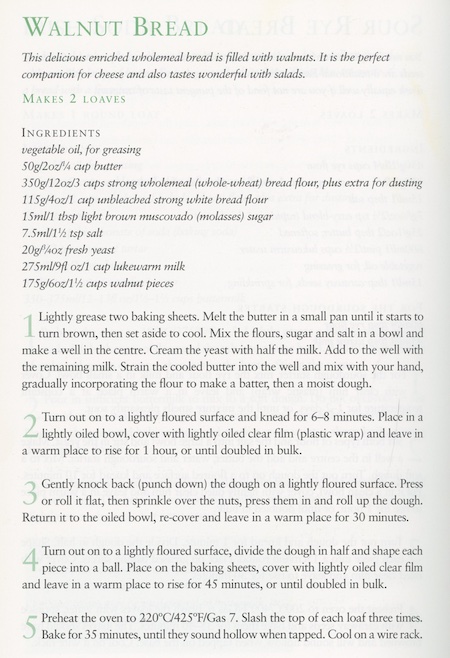 (This book is hard to open out flat enough to follow a recipe while cooking!)
(This book is hard to open out flat enough to follow a recipe while cooking!)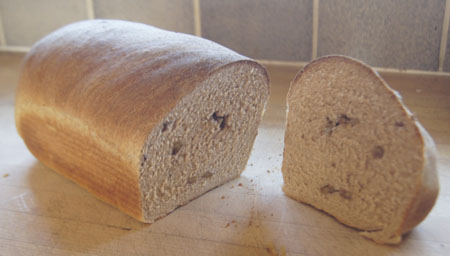 This bread is excellent! I think I found the perfect combination of whole wheat flours to give it excellent flavor and still have good texture – sometimes whole wheat loaves turn out sort of like heavy rocks. The walnuts made me keep wanting to have another bite! Note that this is a good bread for people on a low-carb diet, because it is whole-grain and also has nuts.
This bread is excellent! I think I found the perfect combination of whole wheat flours to give it excellent flavor and still have good texture – sometimes whole wheat loaves turn out sort of like heavy rocks. The walnuts made me keep wanting to have another bite! Note that this is a good bread for people on a low-carb diet, because it is whole-grain and also has nuts.